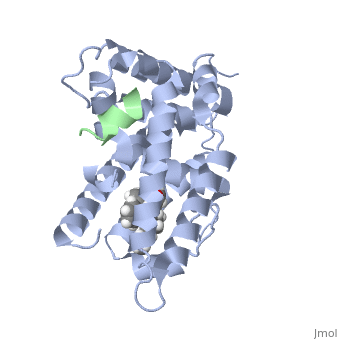5l11
From Proteopedia
Human Liver Receptor Homologue-1 (LRH-1) Bound to RJW100 and a Fragment of TIF-2
Structural highlights
FunctionNR5A2_HUMAN Binds to the sequence element 5'-AACGACCGACCTTGAG-3' of the enhancer II of hepatitis B virus genes, a critical cis-element of their expression and regulation. May be responsible for the liver-specific activity of enhancer II, probably in combination with other hepatocyte transcription factors. Key regulator of cholesterol 7-alpha-hydroxylase gene (CYP7A) expression in liver. May also contribute to the regulation of pancreas-specific genes and play important roles in embryonic development. Publication Abstract from PubMedLiver receptor homolog 1 (NR5A2, LRH-1) is an orphan nuclear hormone receptor that regulates diverse biological processes, including metabolism, proliferation, and the resolution of endoplasmic reticulum stress. While preclinical and cellular studies demonstrate that LRH-1 has great potential as a therapeutic target for metabolic diseases and cancer, development of LRH-1 modulators has been difficult. Recently, systematic modifications to one of the few known chemical scaffolds capable of activating LRH-1 failed to improve efficacy substantially. Moreover, mechanisms through which LRH-1 is activated by synthetic ligands are entirely unknown. Here, we use x-ray crystallography and other structural methods to explore conformational changes and receptor-ligand interactions associated with LRH-1 activation by a set of related agonists. Unlike phospholipid (PL) LRH-1 ligands, these agonists bind deep in the pocket and do not interact with residues near the mouth, nor do they expand the pocket like PLs. Unexpectedly, two closely related agonists with similar efficacies (GSK8470 and RJW100) exhibit completely different binding modes. The dramatic repositioning is influenced by a differential ability to establish stable, face-to-face pi-pi-stacking with LRH-1 residue H390, as well as by a novel polar interaction mediated by the RJW100 hydroxyl group. The differing binding modes result in distinct mechanisms of action for the two agonists. Finally, we identify a network of conserved water molecules near the ligand-binding site that are important for activation by both agonists. This work reveals a previously unappreciated complexity associated with LRH-1 agonist development and offers insights into rational design strategies. Crystal Structures of the Nuclear Receptor, Liver Receptor Homolog 1, Bound to Synthetic Agonists Reveal a Novel Mechanism of Activation.,Mays SG, Okafor CD, Whitby RJ, Goswami D, Stec JO, Flynn AR, Dugan MC, Jui NT, Griffin PR, Ortlund EA J Biol Chem. 2016 Sep 30. pii: jbc.M116.753541. PMID:27694446[1] From MEDLINE®/PubMed®, a database of the U.S. National Library of Medicine. Loading citation details.. Citations No citations found See AlsoReferences
|
| |||||||||||||||||||

